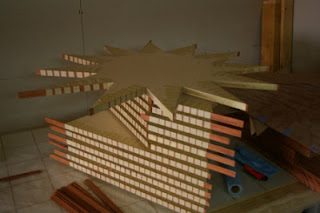So I have been working on a dining table for quite some time now. Actually, it's been a couple of years. The project is a radially expanding dining table. The original concept is credited to Robert Jupe who came up with the idea back in 1835.
Following are some renderings from the computer model used to develop the parts. The internal mechanisms for the table are being custom machined.
 |
| The Table When Small |
 |
| The Table While Expanding |
 |
| The Table When Large |
When small, the table has a diameter of five feet and will seat eight. Then, after expansion, the table is seven feet diameter and seats twelve.
As a starting point for the project I'll begin with the panels.
The table requires six pie shaped wedges, six arrows, and a twelve pointed star in the middle to bring it all together. The first step was to make rough templates of the parts, the templates were used to make the initial panels. These panels were made slightly oversize and then trimmed to size based on templates cut out on a CNC machine. Then edging will be added and veneer pressed on both sides.
 |
| Miter Sled Making the Rough Template |
 |
| Bandsawing to the line for the Rough Template |
The substrate used for the table top components is baltic birch. It is made up of a lamination of 1/4", 1/2", and then 1/4". The 1/2" baltic birch has its surface grain oriented the same as the desired orientation for the veneer and the two sheets of 1/4" are orthogonal to that, this is to help ensure the stability of the panels.
 |
| Stack of Parts Ready for Lamination. |
 |
| The Components are in the Press, Masking Tape Helps with Alignment |
 |
| First Set of Lamination Completed |
The perimeter of the components is edged with 1/8" thick strips of solid wood. The edging was made on the table saw / band saw / thicknesser, nothing too special going on there in terms of techniques.
 |
| Solid Lumber Delivery for the Table, 12'6" |
 |
| 1/8" Edge Materials |
For the top of the panels a high grade veneer was chosen, the underside of the tabletop will also be veneered with the same species (Bubinga), but with a lower quality.
 |
| Kevazinga Veneer for the Top of the Table |
|
|
The edges of the veneer needs to be jointed after the initial cutting, this shooting board allows the clamping of multiple sheets of veneer at once to help ensure consistency.
 |
| Shooting Edges on the Veneer |
Once the edges of the veneers are jointed on the shooting board the veneers can be arranged as below to create a sunburst pattern. The pattern below in the photo can be expanded for as many segments as needed, and ensures that a sheet of veneer is no more than two away from the original sesequence. Then by flipping alternate veneer sheets (the circled numbers) the edges will match up and the sunburst is complete.
 |
| The Pattern Used for the Sequence of Veneer Sheets |
 |
| Sunburst Pattern for the Center Star |




































